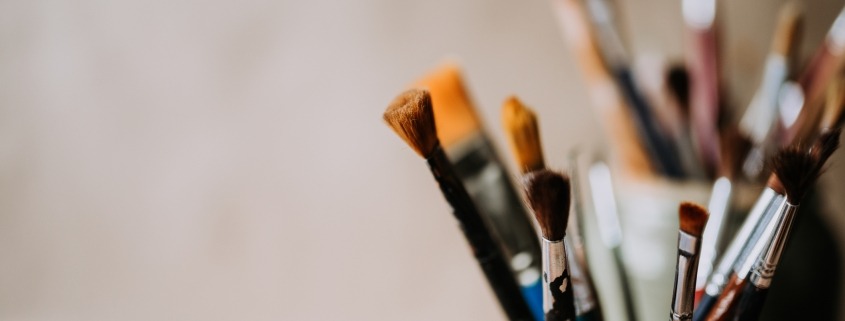Bristle Basics: Synthetic vs. Natural Paint Brushes
When shopping for paint brushes, it’s easy to become overwhelmed by all the options available. In addition to all the different shapes, sizes, stiff or soft bristles, there is also bristle type to consider. Paint brushes come with two basic types of bristles, or “filaments.” The bristles are either natural or synthetic.
What’s the difference?
Synthetic Brushes
Synthetic bristles are made from polyester, nylon, or a combination of both. But they can also be made from lycra, spandex, or rayon. Synthetic brushes are made to mimic the properties of natural hair brushes without using animals. Since they are easy to mass produce, synthetic brushes are budget-friendly and easy to find. Although natural brushes are the original tools of the trade, synthetic brushes are now the most commonly used.
Each synthetic material has different benefits. Nylon is known for smooth finishes, easily picking up paint, and its durability. Polyester is known for holding its shape well, which allows more control. A combination of both nylon and polyester creates a smooth, durable brush.
The fibers of synthetic paint brushes are usually a bright, translucent white, but nylon and polyester bristles actually pick up and hold paint better when they are dyed. As a result, some synthetic brushes have bristles colored white, orange, blue, red, and more.
Pros
- Budget-friendly with many varieties
- Durable and long-lasting
- Require less special care and inexpensive to replace
- Maintain shape well
- Good for fine details
- Works well with acrylics, oils, and watercolors
- Leaves a smooth finish with no brush marks (good if this is the effect you desire)
- Not made from an animal byproduct; more ethically acceptable
Cons
- When exposed to high heat or harsh solvents, synthetic bristles can soften, melt, or curl
- Fast-drying paints can bind synthetic bristles and harden them if not cleaned correctly
- Nylon brushes soften after being used in a latex paint for a long time
- Polyester bristles do not pick up paint as efficiently and need to be dipped more often
Natural Brushes
Natural bristles are made from some sort of animal hair—such as hog, badger, sable, squirrel, goat, pony, or ox hair. There are also natural bristle brushes that use a combination of different animal hairs to achieve a unique effect. It is normal for natural hair brushes to “shed” a few hairs as you use them, but well-made brushes will stop after the first two or three uses.
Sable is considered the ultimate soft brush made from the hairs on the tail of a sable marten. They are known for their softness, flexibility, and fine point. They are considered the best hair for watercolor brushes, for painting fine details, and for painting with thin paint.
Squirrel hair is a soft hair with little spring. Hog bristles are strong yet springy with natural split-ends; they are known as the workhorse of oil painters. Ox hairs create long, springy, and strong bristles often used in flat-shaped brushes.
Many artists find natural paint brushes to be best for oil-based paints and watercolor. Why? The oil in the paint acts as a conditioner to the animal hair and makes them more pliable. Animal hairs also hold more watercolor paint and distribute color more evenly. However, natural hair brushes are not compatible with acrylic paints, which can damage the delicate hairs.
Pros
- Superior paint pick up, hold, and distribution
- Great for oil paints and watercolor
- Great for brushwork and visible brushstrokes
- Develop natural splits in tip and give smoother application
Cons
- Expensive
- Require special care to maintain shape and size
- Not compatible with acrylics and can be damaged by acrylics
- Can shed on the painting
- More difficult for precision
- Not cruelty-free
Synthetic or Natural?
When it comes to choosing between natural and synthetic brushes, it really comes down to your needs and preferences, your desired medium, what you want to accomplish when painting, and your level of expertise.
If you are a beginner looking to get started on your artistic journey, synthetic paint brushes provide an accessible, budget-friendly entryway. On the other hand, if you mainly paint with oil-based paints and are willing to pay more for smoother application, then natural brushes may be for you.
Either way, whether you are a casual beginner starting a new artistic project or a serious expert painter, it is always important to choose the right tools to help achieve your goals and get the best results.
Read Artistic Brushes next to learn more about different brush shapes and sizes!





Leave a Reply
Want to join the discussion?Feel free to contribute!